Google Recovery: Link Based Penalty through Negative SEO Attack
To Google Recovery and beyond
In November 2014 a new client contacted Ashley Turner and his team.
The case: a website hit by a Google algorithmic penalty and a Google partial match manual action. It can´t go worse than this. Actually, it can. It was hit by Negative SEO as well and it all just looked hopeless.
But not for Ashley Turner. Thanks to his brilliant strategy, the right SEO tools and a great effort, the website completely recovered its visibility and ranking.
Read this case study and learn:
- How to recover from a Google Algorithmic Penalty
- How to recover from Manual Penalty
- How to recover from a Negative SEO attack
And most important, learn how to always be one step ahead and protect yourself in the future!
Enjoy & Learn
Christoph C. Cemper
Introduction
In November 2014 a new client approached us with a suspected Google Penguin penalty and a partial match manual action message that had been sat in their Webmaster Tools inbox for over 11 months.
As we signed a non-disclosure agreement, I’m unable to provide the client’s website or name - but I can confirm they are heavily in the UK automobile industry.
Before performing a Link Detox, we plugged the client’s analytics into various diagnostic tools - and saw there had been multiple drops over the previous 18 months that coincided with one Penguin update, however the other drops seemed suspicious. The client had suffered aggressive ranking drops on some strong buying keywords too, resulting in a loss of high converting traffic.
The Recent Penguin Updates
Manual actions are relatively easy to get rid of and most of the Certified Link Research Tools Auditors I’ve spoken with will have a 100% recovery rate on them. Google Penguin Recovery is a lot harder due to huge time gaps between refreshes. However, in October, Google updated the algorithm and in December told Barry Schwartz from Roundtable that:
“That last big update is still rolling out - though really there won't be a particularly distinct end-point to the activity, since Penguin is shifting to more continuous updates. The idea is to keep optimizing as we go now.”
Following major releases you tend to see Google making tweaks, but this ‘continuous Penguin optimization’ presents a valuable opportunity for anyone suffering from Google Penguin to recover more quickly than previous updates – this is the opportunity we wanted to capitalize on.
The client had been using a link removal service throughout this period, failing multiple reconsideration requests, and had no signs of recovery with the Google Penguin update in October 2014.
Initial research showed signs of typical anchor text issues coupled with multiple breaches of Google’s Search Scheme Guidelines. Without diving into a full Link Detox report, it was clear that a negative SEO attack had happened on August 28th 2014 – this would become our top priority and how we almost doubled the client’s search visibility within a couple of days.
In this post I want to share how we increased search visibility by 81.56% in days by diagnosing negative SEO and submitting a disavow file and performing a Link Detox Boost.
I will also share the workflow of the audit and removal process.
Recovery Strategy
In my opinion, the key to a successful link audit and long lasting recovery resides in achieving colossal volumes of link discovery from the outset. By establishing a more complete backlink history to audit, you will achieve higher rankings upon recovery and provide the client with a stable website platform to rebuild on.
You have to find all the skeletons in the closet.
In summary, we apply the following attitude and methodology to the recovery strategy:
- Background research: We call the client to discover what tactics had been employed to build links. This can really help the manual review process for spotting toxic links and negative SEO.
- Experienced auditing: It’s vital the person auditing your site is highly knowledgeable in all forms of SEO as well as the software tools required.
- Superior discovery: As mentioned above, we need to find the source of the problem. By using dozens of tool subscriptions we bring in data from 100’s of backlink sources to unearth as many toxics links as possible.
- Meticulous auditing: Link Detox provides a robust platform for a well-educated SEO to spend some serious time manually evaluating, categorizing and diagnosing a toxic link profile.
- Intelligent removal: The cost of removing good links is huge to both the clients’ rankings and the financial investment of post removal to replace the lost power and trust. The preservation of good links is of the upmost importance.
- Isolating negative SEO: One good thing I can say about negative SEO is that it tends to stick out like a saw thumb in a link profile. As soon as the audit is complete I always advise the instant submission of a disavow file and Link Detox Boost to clear off obvious issues. (Most other cases removal is the best option first as Google recommends)
- Speed & results driven removal: There are tons of monthly link removal programs and agency services out there that remove woeful volumes of links per month. With this methodology in place, recovery can take months - we focus on eradicating enormous volumes of toxic backlinks as fast as physically possible.
Site Audit
A vital part of any recovery is a very detailed and accurate link audit. This client’s website had some serious risk in need of close attention, with a DTOXRISK of 5542! These audits are always difficult to perform - as you can imagine, the percentage of good links could be very low.
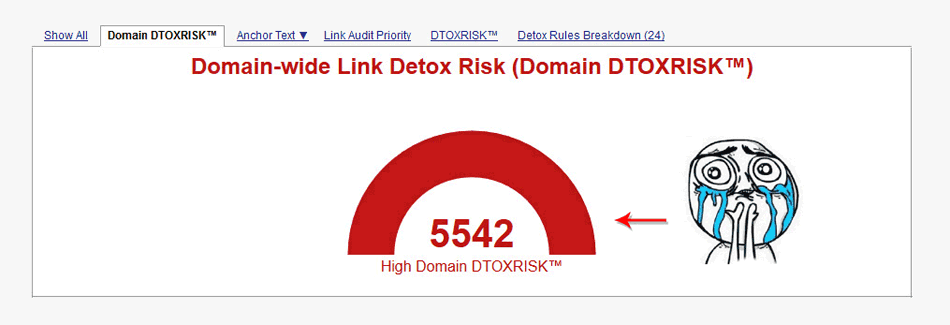

Our Key Audit Goals
We aim to achieve the following with all of our audits:
-
-
- Classify all the anchor text so it’s categorised into Brand, Compound, Money or Other
- Manually work through the entire Link Detox report and audit all backlinks
- Preserve all good backlinks pointing to the client’s website to maintain rankings post-recovery – this also helps the client to understand what they SHOULD be doing following the lift of the penalty.
- Tag EVERY single link using our in-house system – We do this to sanity check the work and create an easier report for the client to digest.
-
Setup and Discovery:
In this instance, we began by grabbing backlinks from EVERY single link we could, through Bing / Google Webmaster Tools, LinkResearchTools Backlink Profiler, Link Detox, and dozens of other premium backlink tools as well as Scrapebox (footprint scraping with search engines).
We merged all the data and de-duplicated it with prebuilt Macros in Excel - Ontolo has a free tool for that if your Excel skills are not that great.
The data was then uploaded into Link Detox with both topdomain and subdomain selected to get as many links as possible. Additionally, we always un-select ‘Remove Dropped Links’ to get the complete picture.
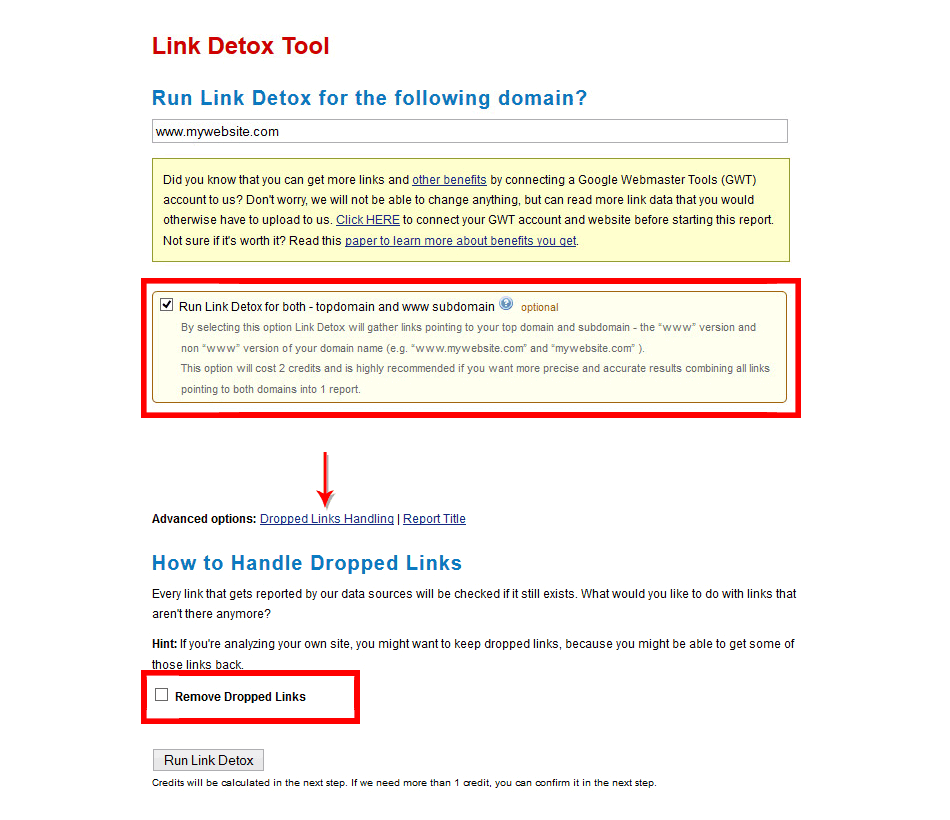
Audit Workflow
Classify anchor text
Once the Link Detox report was complete, we set out to classify all anchor text in the document. The main goal here was to highlight over optimised anchor text and benchmark the split between Brand, Compound, Money and Other keywords against the other sites in that niche.
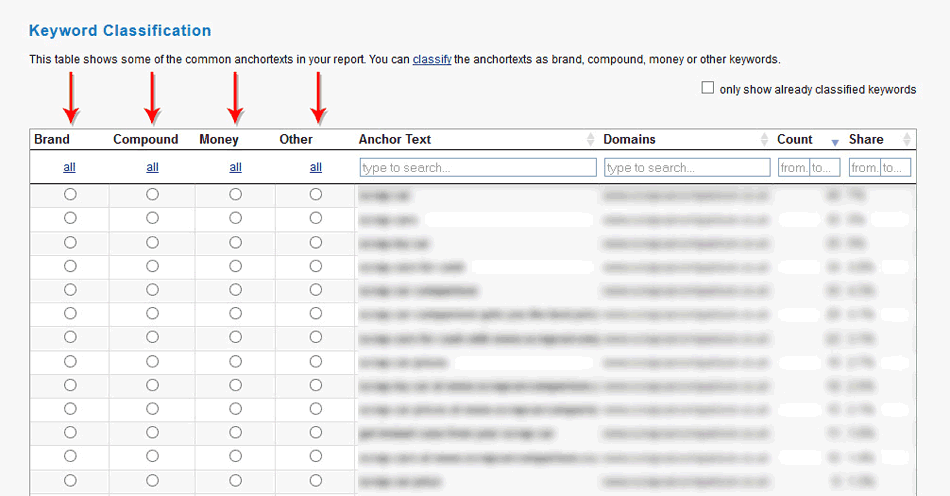
We discovered that this client had highly over optimised keyword (Money) anchor text - over 40% of their profile was one single keyword, used in a negative SEO attack.
Link Detox Screener
After Link Detox had done all the hard work, we had the simple task of applying our SEO experience and knowledge of Google’s link schemes to the links.
The best way to do this is using the Link Detox Screener - it provides my team and I the ability to visually analyse the web page linking to the client. We digest the metrics shown by Link Detox while reviewing the linking page itself – allowing us to rate, disavow and tag the links where applicable.
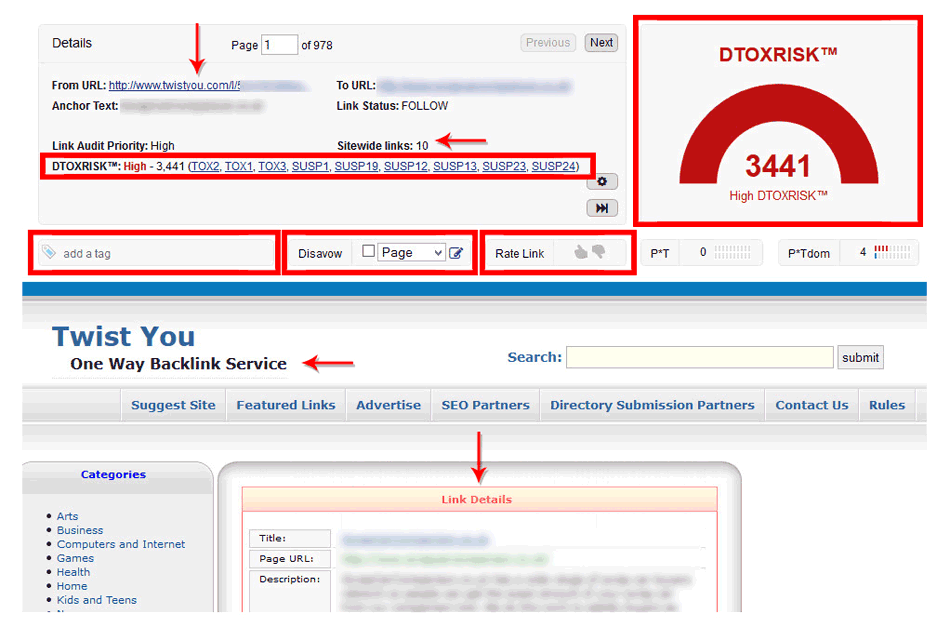
As you can see, you’ll find some obvious SEO websites that scream penalty and would fail a manual review from any Google engineer.
Preserving Good Backlinks
Throughout the manual process of auditing, we discovered powerful and safe backlinks pointing at the client’s website. We tag these good links too, as we feel it’s important to provide some direction for the client’s future promotional efforts. It also allows us to digest positive white hat linking trends within different niches, evolving our knowledge as SEOs.
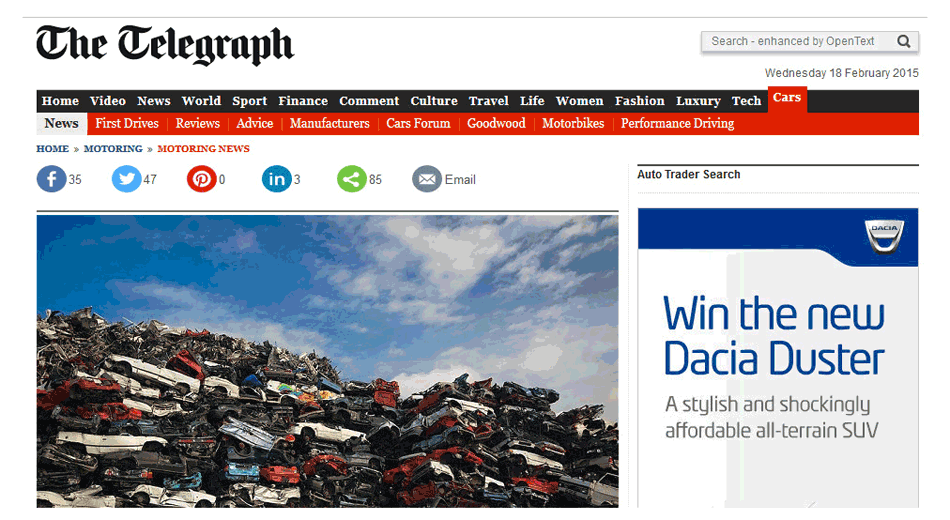
The client had great links driving power to their site from leading newspapers and industry magazines. These are the sort of links that stop your website from being totally knocked out the top 100 ranking results when a penalty hits. They also provide a foundation to rebuild on.
Tagging ALL the Links
I have an up-to-date Google Link Schemes document, numerically tagged, which my staff and I use to categorize links in the audits we do. I enforce this with an iron fist so that, when the audit is finished, we have a solid reason for the vast majority of the links we’ve flagged as toxic.
This greatly boosts the client’s confidence in our auditing when dealing with huge lists of links. Link Detox makes it easy with their Bulk Actions feature (see below) when dealing with link networks or large lists of links you’re 100% sure are one type. However, most of our tagging is done in the Link Detox Screener Mode as we work through the audit.
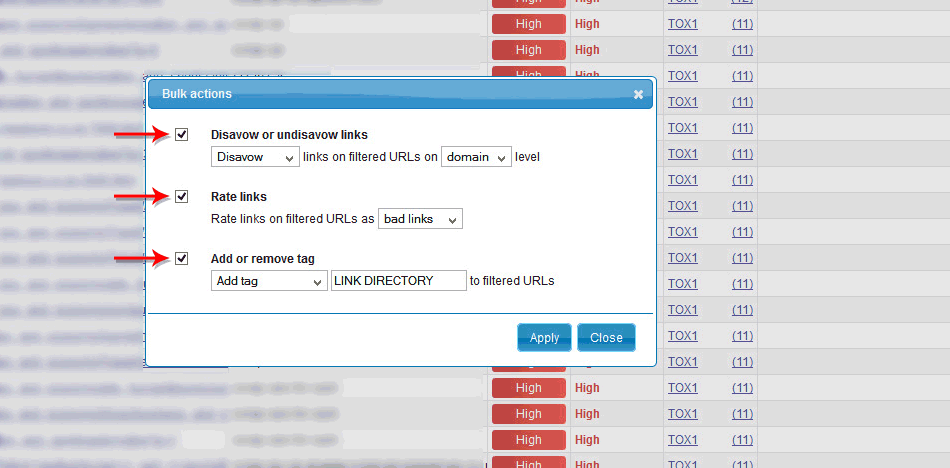
Tip: You can extract columns like the REG and IP address from the Link Detox report and create a pivot table in Excel. This enables you to flag website owners with high numbers of referring links – a common sign of link networks (blog, article, bookmark, directory etc.) – these can be dealt with using Bulk Actions following manual reviews.
Here are some examples of the types of link featured the Google Link Scheme Guidelines:
-
-
- Paid links
- Partner pages
- Article marketing
- Scraper / automated links
- Blog roll or text adverts
- Press releases
- Bookmarks
- Directory spam
- Forum profile / signature spam
- Deindexed domains
- Comment spam
- External link networks
- Internal link networks
- Suspicious redirects
-
Filtering Footprints
We conduct manual searches for URL footprint patterns. This helps us filter the bad links to load into Link Detox Screener – to audit in batches. Here is a list of common URL footprints we use that you can enter into the ‘From URL’ column of Link Detox to identify some typically toxic types of backlinks.
| URL Footprint | Type of link typically found |
| ARTICLE | Shows article marketing websites |
| AUTHOR | |
| DIRECTORY | Link directories – typically low quality SEO directories |
| DIR | |
| DETAIL | |
| LINK | Link directories / partner pages |
| /LINKS/ | |
| PARTNER | Partner pages that may be unrelated and just for link building purposes |
| FORUM | Forum websites that may have profile or thread spam links |
| THREAD | |
| VIEWTOPIC | |
| MEMBER | |
| PLIGG | Bookmarking or voting websites (generally the Pligg CMS platform) |
| STORY | |
| TITLE | |
| VOTE | |
| USER | |
| BOOKMARK | |
| RELEASE | Press releases that may have over optimised anchor texts |
| SEO | Unless your niche is online marketing, this stinks of Blackhat link building |
| WORDPRESS | These platforms were widely used in automated link building |
| BLOGSPOT | |
| COMMENT | Typically scrapebox blasts of blog comments with bad anchor texts |
Link Audit Results
Most of their bad links had come from backlink directories, which is where the negative SEO was, as you can see below. Here is a summary of our toxic backlink findings:
| Bad link type | Percentage |
| Spammy SEO Directories | 44.17% |
| Spammy Bookmarking | 18.79% |
| Low Quality Article Marketing | 13.45% |
| Comment Spam | 5.08% |
| Low quality scraper websites | 4.83% |
| Malware or Hacked Websites | 4.29% |
| Over Optimised Press Releases | 3.65% |
| Link Networks | 2.78% |
| De-indexed Domains | 1.54% |
| Over Optimised Classified Ads | 1.07% |
| Forum Spam | 0.28% |
| Blogroll Links | 0.09% |
Negative SEO Attack
Finding the negative SEO
As you can see from the link growth graph below, finding the negative SEO wasn’t the hardest part of the process. On August the 28th 2014 this client suffered an 847.17% spike in referring pages.
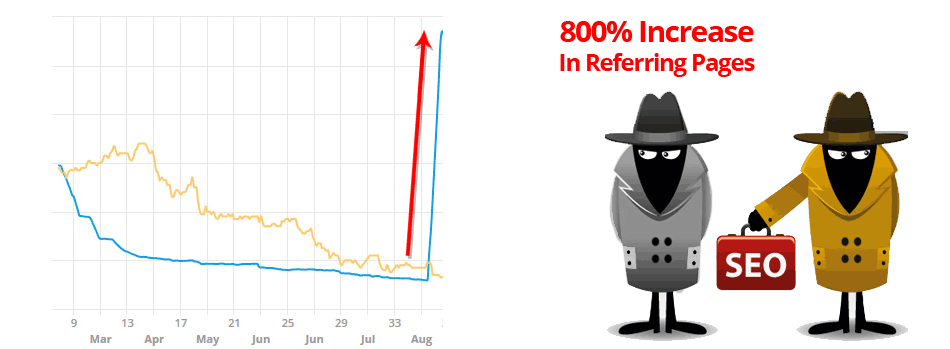
This was the result of a very common negative SEO excoriation tactic, adopted by one webmaster in particular who owns a vast network of link directories. I suspect the reason so many people have links from his sites is due to the wave of automated link building tools that could auto-submit to directories.
I’ll walk you through the entrapment process:
-
-
- The client has a link from one of the webmasters directories.
- The client or average Joe auditor will see the link and flag as spammy keyword anchor text, on a web directory that violates Googles Link Scheme Guidelines.
- The client or auditor contacts the webmaster via the ‘who.is’ records or the automatic $5 PayPal button on the website listing.
- The link gets removed within 24 hours – GREAT!
- Thousands of new links appear across the network of directories – HOLY COW!
- You email to get the links removed and get a bill for $1-4000 from this webmaster with a ‘lifetime guarantee’ that your site is blocked from being on there again.
-
The aftermath
Ouch! The insertion of all these links into your backlink profile will instantly make the keyword pointing to your site shoot up the rankings - I’ve even seen penalised websites get first page rankings again!
A few weeks later these violating links set in like a cancer though, eating away at your business and dragging your whole site down in the rankings. This leaves you with two options:
-
-
- Pay a lot of money for a scam.
- Disavow EVERY site in the webmaster’s network on a domain level.
-
Key takeaways:
-
-
- I can say, with confidence, that 3/10 of our penalty-suffering clients HAVE got links from this website owner.
- Simply having one link from this website owner is enough to trigger a negative SEO attack, if you contact them for removal.
- Google knows: With every reconsideration request I’ve submitted where someone has been attacked, I’ve also provided a link to the email address, IP addresses and domain lists to Google in the hope it will be passed on.
-
I have this full list and I’m happy to provide it to anyone that wants it, simply ask me using my details in the author BIO.
*The only reason I’m not mentioning names or details here is to protect Christoph Cemper from getting the same treatment! :-)
Isolating Negative SEO
Like a patient coming into a hospital with a deadly virus, from the moment we discovered the negative SEO we wanted to isolate the problem and deal with it fast.
Reasons for my direction on this:
-
-
- We want NO room for error in the audit process. I don’t want my staff or I missing a site owned by this webmaster and contacting him for a removal – this can create 4,000 toxic links instantly.
- We can quickly upload a disavow file as a temporary fix while we work on the full audit and removal.
- Using the Link Detox Boost we can force Google to digest and return the client’s rankings and revenue, providing an instant return on investment for the client on our services.
-
So we set out to diagnose the problem in full - the process is detailed below.
Research: Link Network Discovery
I already know the full list of this webmaster’s networks as we’ve crossed paths many times. For the sake of being transparent, I’ve gone through the process we used again step by step. I also want to reiterate that we collected a VAST amount of backlinks from hundreds of sources, so our research data was really comprehensive.
1. We identified footprints in the link spike:
Before we tunnel into the detail, we needed to find an initial footprint clue. We found the most obvious footprint was a keyword that linked to the site, which we could use as a filter in the detox report to then start extracting registrant and IP details.
Other starting point ideas:
-
-
- Look for the dates that links were ‘first seen’ through common backlink reporting tools.
- Download your backlinks and create a pivot table in Excel showing high numbers of similar IP and registrant details.
- Identify one site and search it for obvious text footprints e.g. an email address, custom footer text, phone numbers, terms or privacy text, address. This can then be plugged into Scrapebox or Google using search operators (putting terms in speech marks e.g. “person’s name”) to bring back a starting list where those words appear.
- Identify one site and search it for obvious image footprints. For example you can find a banner or image used, save it on your desktop and drag it into Google image search to show a list of other sites it appears on.
-
2. Load up your Link Detox Report:
In the details section, you need to add some of the general registrant details (REG, IP, DNS, and CNTRY).

3. We entered the keyword to filter:
By entering the negative SEO target keyword into the ‘Anchor Text’ field, we can filter the results for that keyword. This isolated the data we’re mining and made it easier to spot anomalies.
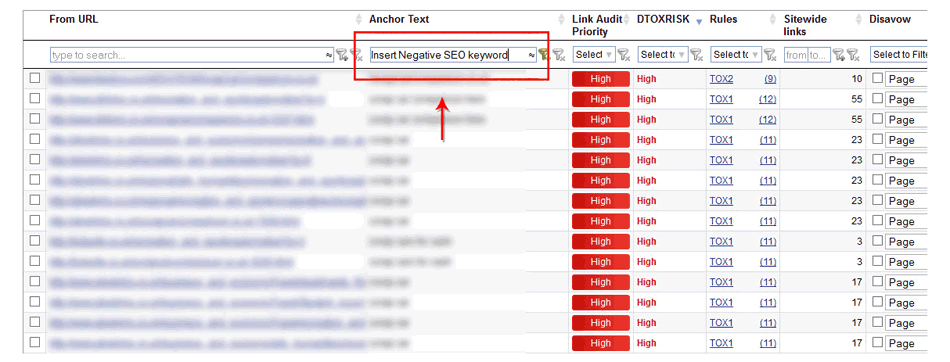
As you can see, all these links look deadly with a high Link Audit Priority and DTOXRISK. Common users of Link Detox will also notice the rule TOX1 is in most of these link columns, which translates to “Domain is not indexed in Google – often a sign for a penalty”
4. Looking for network footprint:
By scrolling right along the Link Detox report, you can find the REG and IP columns we added earlier and sort them looking for matching network signals.
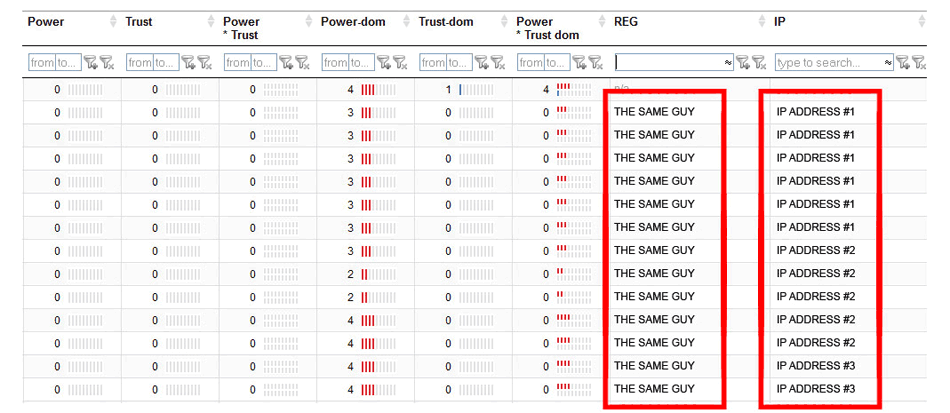
In the above image, we see an example of what we found (names and IPs masked for anonymity purposes). We found the same domain registrant for a few hundred domains with a variety of IP addresses.
To Make Sure We Have a Good Data Set:
-
-
- We exported IP addresses
- Re-enter them into the IP column with ALL other filters off
- Export the lists of domains on those IP addresses
-
WHY? Because the registrant details may be hidden on some domains, IP addresses show all the sites we want to investigate.
This could be exported and uploaded into a disavow file, but…
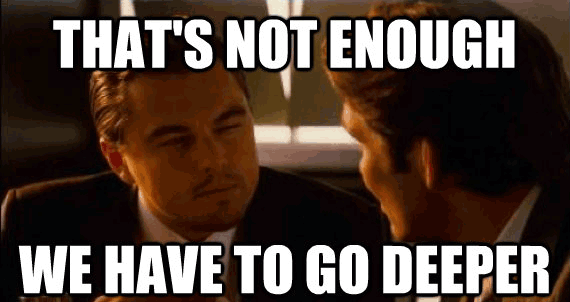
5. Exporting the data
We want to know ALL the domains that have been used in the negative SEO attack. If these domains are deindexed they can be hard for any crawler to find. We used the export function to download a CSV of the IP addresses.

Once they have been downloaded, we simply de-duplicated the IP address column to perform a reverse IP lookup in an attempt to find all websites owner by that webmaster – later merging with our original list.
6. Reverse IP lookup – DIGGING DEEPER:
Having a massive data set from Link Research Tools and our other backlink subscriptions, we had confidence that the IP addresses used to host the network had been found - but not EVERY site on them.
IMPORTANT: I tend to use a website called tcpiputils.com to get my reverse IP data from, as it’s always up to date and works well. It does cost $3 for a good days’ worth of data mining and there are probably other tools - this is simply what we use as I feel I get better results.
Start by searching for each of your IP addresses using the IP Neighbours:
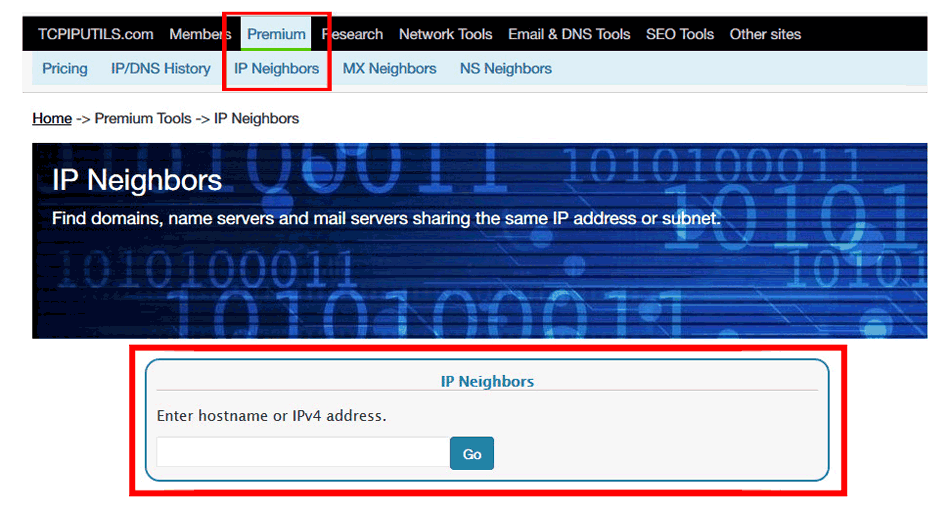
Straight away we grew our list of the offending and potential risk websites owned by the person performing the negative SEO.
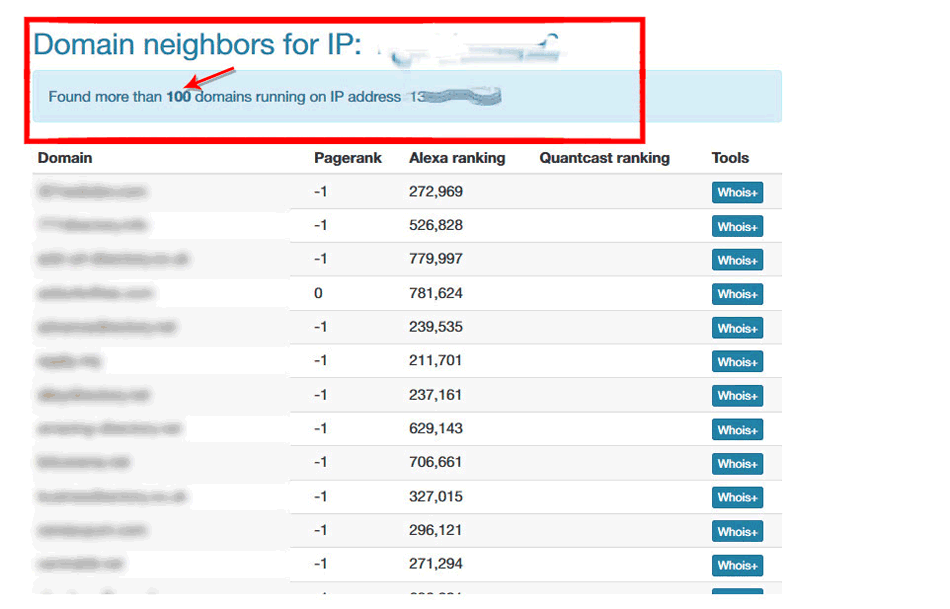
We simply exported the results from all IP addresses and grew our disavow list. This process took me longer to write about than it took us to do and we had a compelling list to instantly make into a disavow file.
As you’re using Link Detox Screener, in the unlikely scenario you find any more links/IP addresses throughout the audit, simply rinse and repeat that process.
Instant Removal & Recovery
Now the negative SEO attack was confirmed, diagnosed and we’d formulated a remedy, we contacted the client. We informed them of the situation and the potential extortion that could follow by attempting to remove the toxic backlinks. They were very understanding and happy to stand back and let us drive.
We recommended submitting a disavow file which contained the negative SEO domains we had researched, using the Link Detox Boost service to get them seen.
We submitted the disavow file, making sure it was error free and setup in the correct format, and processed the Link Detox Boost to get the links visited by Google.
The result:
Days after submitting the disavow file and Boosting the links, we saw the recovery come into play over a 3 week period - seeing an 86% increase in search visibility.

Why this is so awesome?
-
-
- We ONLY submitted a disavow file and used Link Detox Boost to fix it.
- We had removed ZERO backlinks and were auditing the website.
- No reconsideration request was submitted yet.
- The disavow file alone saw an 86% increase in search visibility over 3 weeks.
- It, once again, proves the risks negative SEO can have on your website: clearly a weak negative SEO campaign tanked this popular site’s traffic.
- This proves why link risk management is so important.
-
Don’t be scared about removing links - 44% of this client’s backlinks went with the disavow file and their traffic doubled in three weeks. You just need to make sure you’re deleting or disavowing THE RIGHT LINKS.
Why did they recover so fast?
Google penalty recovery success is down to the following reasons:
-
-
- We identified all the links in the network and future-proofed our client against new links being created in that network.
- Google Disavow is a great asset to a link auditor if used in the right way - by having the right data in, we fixed the Negative SEO problem.
- Link Detox Boost makes the Google Disavow file work fast. You can walk to your recovery or you can take the jet using this tool!
- Google Penguin was being updated at this time too, so some movement will be attributed to the removal of bad links and anchors using the Disavow file.
-
Common Negative SEO Attacks
Negative SEO can come in many forms; here are some examples of the more common methods we’ve seen that you should keep an eye out for:
-
-
- Bad backlinks: Some pretty low-down dirty people use cheap Fiverr gigs and automated tools to blast huge volumes on links at your site.<
- Faking poor user signals: Google don’t use analytics to track your site, they pull in data from any browser (chrome, Firefox, internet explorer, safari etc.). It’s now common that people can trash your rankings, without you knowing it, using bots which interact with your browser and fake negative user signals.
- Content scraping: Duplicate content is a factor that causes ranking issues. It’s nothing new, but you should guard against it using regular checks. I’d recommend checking out Deep Crawl and the Copyscape Tool Siteliner for this. <
- Website hacks: Someone can hack into a vulnerable website (yours or external), insert links alongside questionable content or even scrape your sites HTML and place it on hidden pages on other hacked sites.
- Good backlink removal: The same success we auditors have with link removal of toxic backlinks can be replicated on a competitor’s good backlinks, increasing their penalty risk and dropping their rankings.
- Bad redirects e.g. penalties: When you redirect a penalised website, the penalty follows it - so it should, otherwise it would be really easy to recover from. Negative SEOs can build or buy penalised sites, then redirect them to yours in an attempt to pass on the penalty.
-
Link Removal
At HelloBrave, we’ve done a ton of outreach for link removal, PR and good old fashion white hat link building. We incorporate aspects of the outreach ideas I describe here into our link removal too and you can really see the difference.
Below I describe the data we were provided by the client, regarding the outreach that happened before our intervention, to illustrate how recovery can take too long.
Recovery efforts by the client’s previous agency:
We had a call with the client to uncover the backlink history and services used - they were very open in sharing all old reports. The client had been using a link removal service for the same 11 month period of time with their (now previous) agency. It turned out the agency had been using a low cost pay monthly removal service which is essentially automated.
Example of the poor quality removal service:
Between January - November in 2014 the previous agency had removed 706 links from 100 domains which is an average of 64 links / 9 domains per month. (Far too slow)
Thought: Would an agency you spent thousands of pounds with admit all the work you paid for is trash? No. Whoever created the links that got you in trouble is unfit to audit them, get impartial advice.
Outreach strategy
Create a persona:
Generally I use ‘the business owner’ as the created persona, as we can play on certain emotional strings as well as separating your persona from negativity around SEO and SEO agencies. By doing this, you can portray that you (the business owner) is taking the backlink clean-up very seriously, because you’re handing it personally. You should:
-
-
-
- Explain, in brief, the damage done on your business (don’t be a baby, just explain how your traffic/business has suffered).
- Claim ignorance that the ‘SEO company’ was using tactics you didn’t know were bad.
- Enforce that link building will not be done again (e.g. saying you fired your agency and you’re taking responsibility to clean up yourself).
-
-
Stand out from the crowd:
Don’t use the standard link removal template email stuff. Be different and you’ll be surprised with the impact it can make. For example this was a client in the auto motor industry, so we had our designer make a meme of a crashed car to insert into the email.
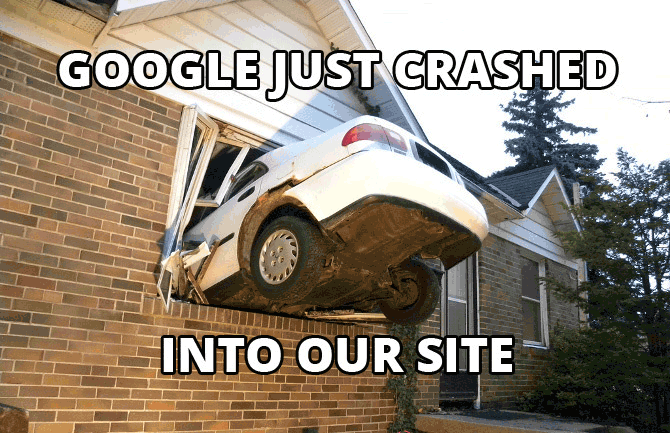
The response rate went through the roof. Webmasters that normally ignore these emails replied, appreciating the humour and effort to stand out (and removing links).
Frequent contact with even spacing:
We didn’t want one email a month going to a webmaster like the previous agency was doing, as that had a poor response rate. We aim to leave about 3-4 days between emails - so you’re not bugging them, but you are staying in the back of the webmaster’s mind. We also emailed after 3pm to hit most time zones.
Emailing tools are essential:
LinkResearchTools integrates with Pitchbox, which enables you to create and dispatch an email campaign very easily. Alternatively you can use something like Gmail with the Yesware or Sidekick plugins installed, which will track open rates - this lets you know your contacts are receiving the emails and can act on them.
Be diverse in your emails:
Asking multiple questions and covering different subjects, almost like a story board, works for your persona. A standard round of emails I’ll use are:
-
-
-
- Introduction email: Explaining the issue, about firing an agency, begging for assistance, being polite, apologetic and sincere.
- Follow up email: Being short, simply asking if they got the last email, reinforcing the removal details and being polite, apologetic and sincere.
- Verify ownership email: Explaining where you got the email address from e.g. who.is records, asking if it’s correct, reinforcing the removal details.
- The ‘hail mary’ last try: Apologise for bugging them, saying you must be a ‘pain in the butt’ and again asking if there’s any chance of help or if the contact details are wrong.
-
-
Then, if you’re confident there are no risky websites in your list, you can try offering a small payment. Google says not to bother with this; I always ask the client if they are open to this. The reasoning is that it gets more links removed for FREE every time. Essentially it provides them with the option of removing any links from people requesting payment, if you’re REALLY serious about cleaning up the backlink history.
-
-
-
- Paid suggestion email: Start by suggesting you could make an offer for payment via PayPal, state it’s only fair to pay for their time.
- Paid incentive email: Consider attacking with an initial offer e.g. $5 per link.
-
-
*Include the links in every email; make it easy for the webmaster to remove them.
Link Removal Tips
-
-
-
When sending out emails, the webmasters you’re contacting may have to remove multiple links from one domain, sometimes masses of links. It makes sense to make this task as easy as possible and not put them off with a huge list of links. This means cleaning your data - only providing the URLs with the original backlink on them. For example, on a WordPress site you can remove all the links by just deleting the article post:
- Domain.com/article-post – Original link
- Domain.com/category/ – Link only exists because of the original article
- Domain.com/tag/ – Link only exists because of the original article
- Domain.com/author/ – Link only exists because of the original article
- We created good email signatures that look legitimate and feature contact details, logos, photos, and privacy disclaimers. Wisestamp is a good plugin to set this up fast.
- We tracked open rates to see what removal leads were hot and where we will need to go and source a new contact for that domain, as there was no pickup.
- Every bounce back email we got would get removed from the campaign and a task to source a better contact was set up. We visited those domains to find contact forms and new email addresses.
- We got creative with email subject lines, as we NEVER mention link removal or anything of the sort in the subject - the goal is to get an open from the webmaster and let the email copy convert that into a removal.
- We were always polite and stayed in our persona character.
-
-
Outreach Results
We had 1307 backlinks to remove; the results of our 3 week outreach campaign were as follows:
-
-
-
- My team and I at HelloBrave removed 944 links / 306 domains from 1307 backlinks.
- This was a total removal rate of 72.22%.
- This was completed over a 3 week period.
- From all the links removed over the year, the client had tidied up over 80% of their bad profile.
-
-
*These numbers were taken from the removal in the 3 week period only. Following this, more links disappeared over Jan/Feb 2015 – typically as webmasters take some time to get around to removing, getting access to their old sites, checking old email accounts and so on.
All these efforts were a perfect to swim through a reconsideration request - they did this on the first try!
Reconsideration Request
Following the successful dispatch of the negative SEO, Link Detox audit and outreach - eliminating the toxic backlinks pointing at the client’s site - we were ready to submit a reconsideration request.
-
-
-
- We updated the Disavow file containing the negative SEO domains with the toxic links from the audit and submitted it.
- We uploaded all the documentation to Google Drive.
- We wrote an honest reconsideration request note to Google, that linked to the documentation in Google drive for reference of the work undertaken.
-
-
We included documentation in the request:
-
-
-
Excel spreadsheet with 3 columns of toxic link statuses
- Removed backlinks from our outreach
- Toxic links that are blocked from indexing or have No Follow tags and were added to disavow
- Links where we had no response from webmasters and disavowed
- Negative SEO spreadsheet containing the domains, webmasters email address, registration details and known IP addresses
- PDF containing screenshots of us competing contact forms on webmaster’s sites
- PDF of the outbox emails being sent as proof of our efforts
- A copy of the updated disavow file
-
-
The request was accepted first time and the client received a notification in their webmaster tools a few weeks after the submission.
Google Recovery Summary
Negative SEO Recovery
We diagnosed a negative SEO attack.
-
We looked deeper to find all offending domains.
-
The site’s visibility doubled in 3 weeks.
-
- We recovered a client with JUST a Disavow file and Link Detox Boost.
Google Penguin Recovery
As Google Penguin continuously updated over December, we saw several penalised terms come back onto the first pages of Google
-
- These keywords had not been in the top 100 for over year
This showed the client that they have got the ability to rank for these again IF they do their digital marketing the right way.
Reconsideration Request
- We accurately audited the website’s toxic links, to have no further drops and maintain current rankings.
- We removed 72.22% of the clients’ bad links in 3 weeks.
- We submitted a new disavow file to include the toxic links discovered in the audit.
- We swam through a reconsideration request first time.
Following all the acceptance of the reconsideration request, removal of a ton of toxic links and a fresh disavow being submitted the final stage of the recovery happened and the majority of the clients’ keywords came back to the first page seeing their search impressions triple.
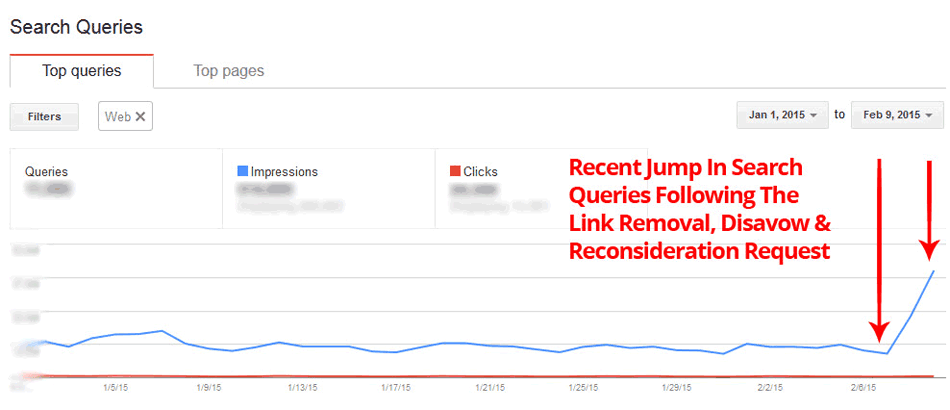
Closing thoughts
If you walk away from reading my post with anything, I’d like you to keep these points in mind:
- Find every backlink possible to audit using as many sources as possible, making the recovery dependent on your audit ONLY and not failing due to the weak data set you’re using
- Disavowing chunks of links is scary, but my god does it pay off if they’re bad links.
- Google say to use disavow as a last resort but, if you’ve been hit with negative SEO, you will suffer faster than you can remove those links - switch up your program disavow and look at deleting links after, if that’s an option.
- If you find a negative SEO attack, putting the time into fully diagnosing the problem making it your first priority and you can make a huge difference to the clients recovery speed.
- Being smarter in your approach to link removal outreach can not only remove vast amounts of bad history, but put less dependence on your disavow file.
This case study was written by our new LRT Certified Professional Ashley Turner, Head of Search at HelloBrave.com, and proud user of LinkResearchTools and Link Detox.
A word from Christoph C. Cemper
This intriguing and very instructive recovery story proves that there are no hopeless situations if you have the right tools and a good work strategy.
Ashley shared his experience and many helpful tips we can all use in everyday work.
Our goal is to provide our user community and clients with quality service and knowledge. Our LRT Certified Professionals and Xperts are key to achieving this goal.
I look forward to Ashley Turner´s future work and personally I recommend working with him whenever you get the opportunity.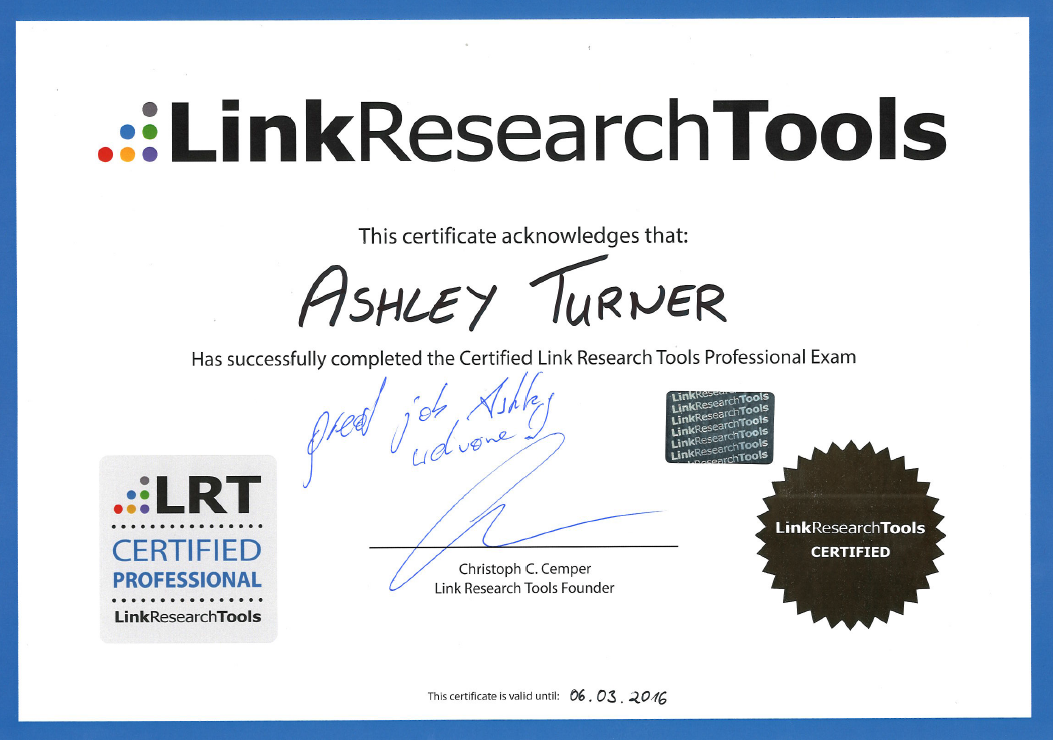
 With the Superhero Plans you can perform link audits, link cleanup, link disavow boost, competitive research, professional SEO and backlink analysis for your own or your competitor's sites.
With the Superhero Plans you can perform link audits, link cleanup, link disavow boost, competitive research, professional SEO and backlink analysis for your own or your competitor's sites.
You can fix or avoid a Google Penalty! Learn more about how you can Recover and Protect with LRT.
Learn how LinkResearchTools helps you recover and protect your website rankings